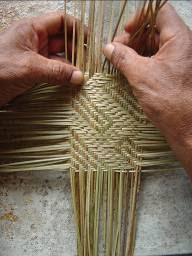Weaving the collective and the self in art

Indigenous art has the power of a mirror where the collective and the self, the ancestral and the re-signified meet and interact. It's incredible to think about the infinitude of layers of meaning embedded in a single object that has also passed to be a marketable item. And knowledge endures, transforms, erodes, but still persists. Kaiabi basketry for example, topic of my research, brings a symbolic and mythical language encoded in the more than 30 different designs still woven by Kaiabi men. They are symbols who provide constant ethnic reiteration, just like an ethnic brand.
Many of graphic designs produced in basketry refer to Kaiabi myths, such as the design named awasiayj (maize grain), which is mentioned in the myth of Origin of Cultivated Plants. There is another design that represent enemies killed in battles, named "Tangap". Another one refers to frogs (Kururu), important animal mentioned in many Kaiabi myths.

Kaiabi basket with design named Kururu'i (little frog).
Traditional ways of learning how to weave a basket include observing somebody; observing a ready made basket;and also by taking a piece of woven basket from garbage and copying it. This is also in Kaiabi mythology. In a very interesting and funny myth, Kaiabi ancestral hero Tuiarare was traveling to fetch some natural resources for many, many years, until he arrived in a snake hut. The snake was mean and wanted to eat him. He started to mention names of animals to distract her, but she would not let him go. Until a moment, in the morning, he called the name of the great hawk who eats snakes. She got afraid and let him go. On his way out, he got a piece of skin of the snake that was hanging from a wall. He took that piece of skin back to his village and learned to weave baskets copying from the snake's skin. And then he taught the Kaiabi people how to do it. And this happens since...until nowadays. Men learn by observing a piece of "skin". Myths are fascinating because they tell an ancestral story that has perpetual meaning...just like an apparent "simple" basket...who said there is no magic in the real world?

Drawing of ancestral hero with snake and hawk done by the student Iwa Kaiabi in Kururu Village, Xingu Indigenous Park, 1999.
Comments